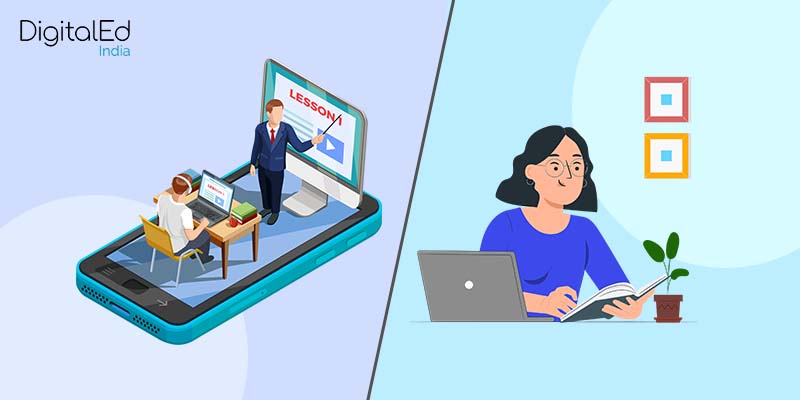Flip Learning vs Blended Learning: Difference, Effectiveness, and Implementation

Flip Learning and Blended learning are terms and techniques which have come to existence due to technology-induced revolution in current times. Flip learning was introduced and implemented for the first time by the USSR that is present-day Russia. It is a method of learning where teachers segregate topics of active learning to be taught in the classroom while other topics of lecture and presentation are assigned to the students to be covered by them at home.
Talking about Blended learning, also known as hybrid learning, is an approach that combines both online and traditional offline ways of teaching students. The education materials for the online and offline classes are also divided accordingly. The execution pattern of Blended learning may vary from school to school.
Difference between Flipped and Blended learning
Flipped and Blended learning, both the methods of teaching and learning are becoming very popular nowadays. However, there are some differences between them that we need to look into.
Flipped learning, also known as the Flipped classroom, is a mixture of both online and offline learning. But here teachers or educators do not teach offline. Here students are given topics of lectures and presentations to be studied on their own and then come to class where more complex and detailed study can be done on the given topics or new ones. Students can also be assigned videos to watch to gain clarity on a topic before discussing them in the online classroom.
Blended learning differs from Flipped learning in the sense that here not all the study materials are online. Subject matters are divided into online and face-to-face and offline classroom materials. Here classes are both in online and offline mode, and online materials do not take the place of face-to-face interaction between teachers and students, instead both the modalities complement each other. These two techniques truly blend with each other for an enriched and comprehensive learning experience for learners.
Making Flipped Classroom More Effective
Flipped learning is a comparatively new and advanced way of teaching, but a technique in itself cannot do it all. That is why we need certain ways to make it more effective. Here we are going to discuss how to do that.
Segregation of Elements: Segregate the topics of the curriculum that needs to be covered in the online classroom and topics that needs to be dealt with by the students themselves. Out-of-classroom materials can be shared through soft copy, eLearning videos, audios, PPT, etc. It is advisable that the easy topics should be covered by students on their own while the difficult ones need to be kept for detailed discussion during online classes.
Application of Knowledge: Making learners apply their knowledge is the best way to let the student grasp what they have learned before coming to the class. Thanks to the segregation method that lectures get already covered by students and now the folks are ready to implement their knowledge. It could be done through interactive role-plays, classroom project-based learning activities, etc.
Make Online Study Material Concise and Clear: Since students are dealing with online study materials on their own, it must be clear and concise. You need to be incredibly careful about the words used in them and the length of them. Otherwise, there are high chances you will either bore them or overload them with information. So, the key to making it more effective is to make it easy and interesting.
Difference between Traditional Classroom and Flipped Classroom
Flipped and Traditional classrooms are not just two different modes of teaching, but the way students are taught differs widely. In a traditional classroom, it is only the teacher and the books that are the sources of knowledge for students. Also, in traditional classrooms, they are only given the basic knowledge of the subjects, and more complex matters are dealt with by the students themselves in the form of homework. Whereas, in Flipped learning the opportunity to learn for students is wide and open. Here, students have direct access to knowledge in the form of online study materials. They can explore their subjects as much as they want and can have a deeper understanding. Students already have a fine idea of the subjects they are going to study in online classrooms, and they are ready to implement their knowledge. It is a more active way of learning than the traditional classroom model.
Implementation of Flipped Learning
There are a few things that need to be kept in mind before beginning a Flipped classroom for proper and effective implementation of flipped learning. What are they?
Have Your Technology Ready: The flipped classroom is a gift of the technology revolution and depends heavily on technology. Flipped learning requires you to make and share videos with students related to their study material. So, you need a platform that is best for you to make, edit and share videos. You also need a hosting service and need to determine how your students will access your content.
Student Accountability: Make your students accountable for their learning activity so that they sit in the class with a sense of responsibility and are ready to learn. Your role should be supportive and guiding rather than leading the classroom.
Start and End of the Class: You should start the class by taking doubts from the students. These doubts could be either from a previous class or from video lectures. Also, before ending the class, you should brief your students about the next class.
Flipped and Blended classrooms have provided the new generation of teachers and students with a fresh and innovative way of teaching and learning, respectively. It breaks free from the limitations of traditional education and opens a wide range of possibilities for students benefiting from this.